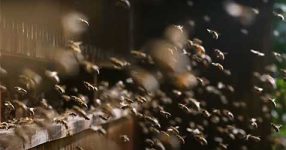In the documentary “Bees: A Life for the Queen” the narrative unfolds with a glimpse into the lives of bees as they contribute selflessly to their perfect society. Each individual in the colony demonstrates dedicated hard work, with a shared focus on accumulating wealth in the form of nectar and pollen. The communal efforts of the bees come to light as they fiercely defend the hive against unwelcome intruders, showcasing their singular concern – the defense of the colony.
As the documentary delves into the intricacies of bee behavior, it becomes evident that everything in the community functions with relentless precision, all serving a singular purpose – the survival of the colony. The bees’ existence revolves around a harmonious collaboration, emphasizing the collective effort to ensure the prosperity of the hive.
The Queen’s Role and the Cycle of Generations
At the heart of the bee society is the queen, whose life is dedicated to producing successive generations of workers. The workers, in turn, tirelessly labor for the queen. The documentary captures the fascinating journey of nectar, the life-giving fuel for bees. Each worker undertakes thousands of flight hours to gather this precious liquid, only to selflessly share it with their fellow bees upon return to the hive.
The nectar undergoes a transformative process, from being concentrated to ripening into honey, symbolizing the industrious nature of the bees. The colony’s wealth in honey becomes a target for nocturnal predators like the death’s head hawkmoth, which employs clever disguises and deceptive tactics to infiltrate and steal from the hive.
The Complex Society and Life Cycles
Beyond the apparent chaos of the bee world lies a meticulously organized society where every member has a specific task, and everything has its designated place. The documentary highlights the separation of pollen and honey in storage cells, emphasizing the precise orchestration of the hive’s activities. The intricate process of determining the roles of worker and queen bees unfolds, revealing how feeding a grub with royal jelly transforms it into a potential queen.
The life cycle of the queen, worker bees, and drones is explored, showcasing the intricacies of their development within the hive. The narration captures pivotal moments, such as the departure of the old queen, the swarming process, and the establishment of a new hive. The bees’ collective decision-making and collaboration are underscored as they face challenges in finding suitable locations for their colonies.
Challenges and External Threats
As the documentary progresses, it introduces challenges faced by the bees, including unpredictable weather conditions and external threats. The bees’ incredible workload, from foraging for nectar to processing honey, is highlighted, emphasizing the immense efforts required to produce even a single liter of honey. External factors like rain pose significant risks to the bees, potentially grounding them and exposing them to various threats.
The narrative explores encounters with creatures like mice and bee-eaters, showcasing the delicate balance between the hive and its surrounding ecosystem. The bees’ ability to defend their hive against potential threats is depicted, emphasizing the intricate relationships within the natural world.
The Queen’s Battle and Colony Division
One of the documentary’s climactic moments is the emergence of a new queen, sparking a battle for succession within the colony. The unique circumstances of a drawn battle lead to a rare decision – the division of the colony. The departing swarm embarks on a risky journey, reflecting the bees’ programmed instinct to follow the queen for the sake of the colony’s survival.
The challenges faced by swarming bees, such as finding a suitable home, are depicted, showcasing the resilience and adaptability of these social insects. The narrative takes an unexpected turn as the swarm seeks an unconventional resting place, leading to a surprising intervention by the fire brigade.
Human Interaction and the Beekeeper’s Role
The role of human interaction is briefly explored as the documentary introduces the beekeeper. The beekeeper, while extracting honey as a form of rent for hive management, demonstrates a commitment to ensuring the survival of the bee society through the winter. The delicate balance between human intervention and the bees’ natural existence becomes evident in this symbiotic relationship.
Reproduction and the Cycle Continues
The final segments of the documentary delve into the queen’s reproductive role, ensuring the colony’s future through the laying of thousands of eggs. The queen’s chemistry enforces her reproductive monopoly, maintaining the order within the hive. The cyclical nature of the bees’ existence is emphasized, showcasing the continuous journey of life, reproduction, and survival.
“Bees: A Life for the Queen” offers a captivating exploration into the intricate and captivating world of bees, unveiling the complexities of their society, challenges faced, and the relentless pursuit of survival for the greater good of the colony.












